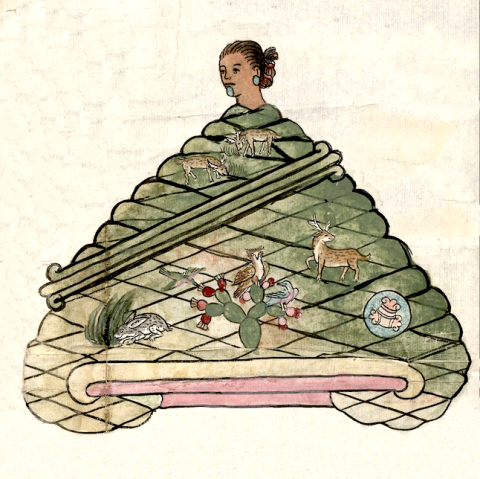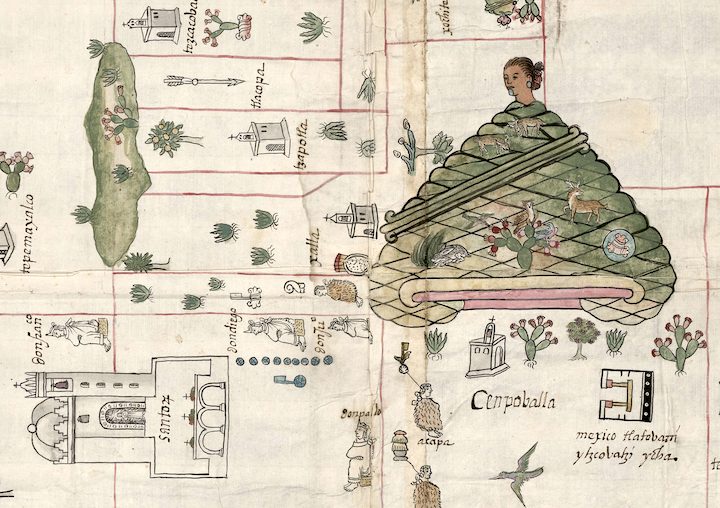Cempohuallan (CmpRG)
This compound glyph stands for Cempohuallan (seemingly meaning "Place of Twenty," also spelled Cempoala and Zempoala), the name of the principal socio-political unit featured in the 1580 Relación Geográfica de Cempoala (of Hidalgo). The most obvious element is the grand hill or mountain (tepetl) that sits in the center of the map--the compound glyph shown here. This is surmounted by a beautifully realized head of an obviously high-status man in a 3/4 view (showing both eyes, which suggests European stylistic influence). However, Cempohuallan does not obviously contain any phonetic or iconographic element provided by the grand hill. Instead, this elaborate element seems to play the role of a semantic indicator establishing that this is a place, or in other words for the non-visualized locative -tlan, “by, among, in,” etc. The high-status individual whose head appears on the summit of the hill/mountain has a large turquoise disc for a lip plug as well as turquoise ear flares (one assumes that the ear that does not appear in the painting had one, too). His hair is gathered with a red-colored winding cord into the warrior hairstyle called temilotli or tzontli. According to the Spanish-language text, Cempohuallan “means twenty in Spanish, because in ancient times the Cempoaltecas lived in this pueblo; they speak the Mexican language [Nahuatl]” (folio 1 verso). Thus the head on the summit most likely represents an ancestral figure or ethnic group that founded the community in "antiquity," with the word for “twenty” (cempohualli) as the main component of the name. Finally, the compound glyph is closely associated with an elaborate depiction of the region's Franciscan monastery church to its left. Another option is that the man at the top of the hill is a centecpanpixqui (guarding over twenty tributaries). This church, which has decorative elements still found on the existing building (such as its rare sixteenth-century bell tower) is a semantic element indicating an inhabited place (see the historical contextualizing image).
Robert Haskett
Who were the Cempohualteca? Were they from Cempohuallan on the Veracruz coast, or was their leader, “a Cempohualtecatl, a person of the Toltec kingdom of Tollan, something discussed by Miguel León-Portilla” as Stephanie Wood wonders in another entry in this Visual Lexicon? The present manuscript itself notes that the “ancient Toltecas” had influence in the region, but does not link them directly to the founding group of Cempohualteca. At this remove, and without more information, this conundrum cannot be cleared up. Turning to the tepetl, it has a typical bell-shaped profile and the expected black-bordered lines at its base, the upper one rendered in tan and curling in at each of its ends around the middle hot pink-colored one, which in turn sits on a shorter one of the same color. The surface of the hill, green at the top shading to tan on its lower reaches, has a quilted pattern that Barbara Mundy believes represents the scaly skin of the primordial earth monster, Tlaltecuhtli. A diagonal elongated tetl element adds the meaning rock or stone to the mix. It appears to act as a semantic indicator showing that the hill is rocky, but it is also a phonetic reminder that the term tepetl starts with -te.
Other elements on the hill are less easily explained, however. The three deer (mazatl) standing on its slopes and a rabbit (tochtli) stationed next to what appear to be reeds or tall grasses echo the Spanish text’s description of the fauna in the Cempoala region (“venados, conejos”). But the meaning of the three-ended tetl in a blue circular element on the lower right slope is not immediately clear (circular elements with blue-painted insides stand for water features elsewhere on the map). The nopal cactus standing above the bordered lines near the base has three birds associated with it: a hummingbird (huitzilin) feeding on a cactus flower; an owl perched on top of the cactus; a cotinga bird (xiuhtototl) with blue feathers on its back and wings, and purple on its chest. An apparent visual catalogue of local vegetation is seen below the tepetl, a line of plants that includes magueys, a nopal cacti, and what appears to be a native cherry-like tree (capolin, or “cerezo de la tierra” in the Spanish text).
It may be that some or all of these elements on or closely associated with the hill have deeper meanings. Rabbits were associated with the moon, fertility, pulque, and drunkenness. Yet being born on a day with the calendrical sign tochtli might be fortunate or not, depending on the number associated with it (among other things). Being born on a day with deer (mazatl) sign could be similarly fortunate or unfortunate. According to the Florentine Codex, various proverbs held that those who “no longer lived at home, who no longer obeyed his father, his mother…[who] just went wandering about somewhere” made themselves “into a rabbit…into a deer” (Anderson and Dibble, Book 6, “Rhetoric and Moral Philosophy,” 253). Horned owls (tecolotl) were considered to be harbingers of death or disaster, for instance. Brilliant blue cotinga feathers were used in crafting elite regalia, and of course hummingbirds were associated with the Mexica’s patron deity Huitzilopochtli, among other things. Still, as of this writing it is not possible to divine with any certainty what, if any, deeper meanings are being expressed by the fauna depicted on Cempohuallan’s place glyph. That said, the large, painstakingly detailed compound glyph for Cempoallan most obviously expresses—metaphorically and artistically—the town’s political legitimacy and domination of the surrounding territory. For more information about the map, see Biblioteca Digital Mexicana, A.C., http://bdmx.mx/documento/mapas-relaciones-geograficas-cempoala-epazoyuca... Mundy, Barbara E., “Mapping Babel: A Sixteenth-Century Indigenous Map from Mexico,” The Appendix, 1:4 (October 2013), and Mundy (1996), and Ballesteros García (2005), 55-56, for a somewhat different interpretation of some of the glyph's elements.
Robert Haskett
Cenpoualla
Cempohuallan (Cempoala, Zempoala)
Robert Haskett
1580
Robert Haskett
twenty, veinte, ear plugs, lip plugs, lip-plugs, labrets, enchufes, tapones, labios, bezotes, adornos labiales, jewelry, jollas, nombres de lugares

cempohual(li), twenty, https://nahuatl.wired-humanities.org/content/cempohualli
-lan, with; next to; in; between; in the company of; below; to; near, https://nahuatl.wired-humanities.org/content/lan
centecpanpixqui, guardian over twenty tributaries, https://nahuatl.wired-humanities.org/content/centecpanpixqui
Relación de Cempoala - University of Texas Libraries Collections. 1580-11-01. https://collections.lib.utexas.edu/catalog/utblac:f87917e2-e3c9-4eb2-a83...
Materials that are in the public domain (such as most of the maps in the PCL Map Collection) are not copyrighted, and no permission is needed to copy them. You may download them and use them as you wish. The image appears here courtesy of the University of Texas Libraries, The University of Texas at Austin. If you do publish anything from this database, please cite the Visual Lexicon of Aztec Hieroglyphs.









